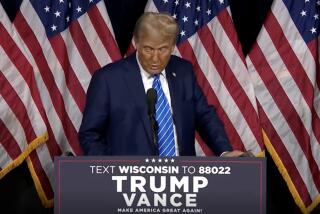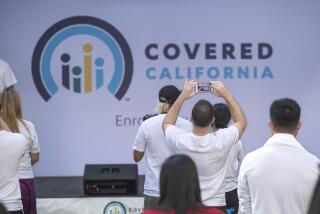Obamacare sign-ups surge, despite Trumpâs calls for repeal
Reporting from Washington â Nearly 9 million Americans have signed up for health coverage in 2018 through the federal HealthCare.gov website this year, according to an initial report from the Trump administration of the six-week enrollment period that ended last week.
The tally, though incomplete, suggests that enrollment on the HealthCare.gov insurance marketplace created by the Affordable Care Act will nearly equal the 2017 total despite uncertainty in the markets, a shorter enrollment period and steps by the administration that appeared aimed at discouraging people from signing up.
With sign-ups continuing in all or parts of 17 states, including the nationâs largest, total enrollment may ultimately surpass the 2017 tally.
The enrollment period on HealthCare.gov was half as long this fall as in previous years, and the Trump administration slashed funds for advertising and outreach. The president also often publicly referred to Obamacare as âdeadâ or âover.â
âObamacare is finished. Itâs dead. Itâs gone,â Trump declared on the eve of the open enrollment period, which began Nov. 1.
In 2017, more than 12 million people signed up for Affordable Care Act marketplace plans, including about 9.2 million through HealthCare.gov.
Through last Friday, more than 8.8 million people had signed up for 2018 coverage through HealthCare.gov, according to the administration.
That includes nearly 2.4 million new customers and 6.4 million returning enrollees, many of whom were automatically re-enrolled.
âItâs incredible how many people signed up for coverage this year with record-setting demand for affordable health coverage,â said Lori Lodes, a spokeswoman for Protect Our Care, a non-governmental advocacy group that stepped in to publicize the marketplaces when the Trump administration slashed outreach efforts.
âThe demand for affordable coverage speaks volumes â proving, yet again, the staying power of the marketplaces,â Lodes said.
Seema Verma, a Trump appointee who heads the federal Centers for Medicare and Medicaid Services, who has been conspicuously silent about the enrollment period this year, announced the tally in a Twitter post Thursday.
âGreat job to the @CMSGov team for the work you did to make this the smoothest experience for consumers to date. We take pride in providing great customer service,â Verma tweeted.
The marketplaces â a centerpiece of the law commonly called Obamacare â have primarily served low- and moderate-income Americans who donât get health benefits through an employer or a government program such as Medicare or Medicaid.
They have been buffeted all year by uncertainty over their future, with insurers in some areas raising rates steeply or exiting markets altogether.
That has been particularly tough for consumers who make too much to qualify for federal insurance subsidies through the healthcare law.
The law offers subsidies to Americans making between 100% and 400% of the federal poverty line, or between $12,060 and $48,240 a year.
Many insurers also concentrated the rate hikes in certain plans. Because of the complex way the law calculates subsidies, that means many consumers will pay less for coverage in 2018.
Nine of the 17 states where people can still sign up for 2018 coverage â including California, Maryland, Connecticut and New York â operate their own marketplaces and are holding longer enrollment periods. Californiaâs goes until the end of January. Marylandâs is scheduled to close Friday.
Residents of all or part of eight more states that rely on the federal HealthCare.gov site have until Dec. 31 because the states were affected by extreme weather this fall such as hurricanes.
Among the states affected were Florida, Georgia and Texas, all of which have had substantial enrollment in past years.
More to Read
Get the L.A. Times Politics newsletter
Deeply reported insights into legislation, politics and policy from Sacramento, Washington and beyond. In your inbox three times per week.
You may occasionally receive promotional content from the Los Angeles Times.











